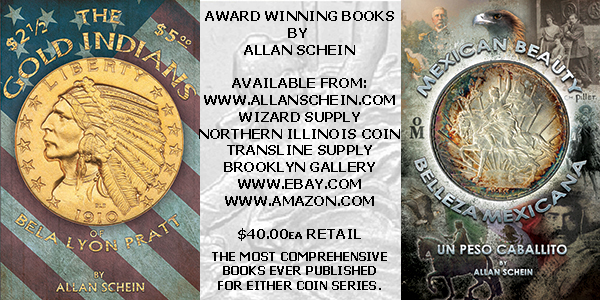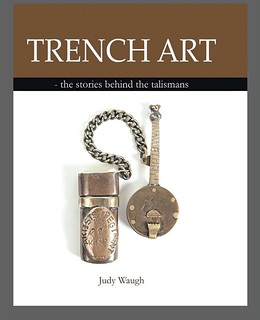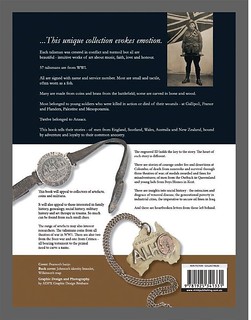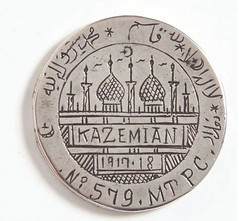
PREV ARTICLE
NEXT ARTICLE
FULL ISSUE
PREV FULL ISSUE
BOOK REVIEW: TRENCH ARTCarol Bastable is President of the Love Token Society and editor of their Love Letter newsletter. The December 2017 issue includes a review by Fred Schwan of the 2015
Trench Art book by Judy Waugh. Carol kindly gave permission to republish the article here. Thank you! -Editor
This is the only trench art book in which the author does not feel compelled to tell readers what trench art is. In addition to being a trench art book, this is a coin book. Again, the author understates this aspect. It is unlike almost all numismatic books, but it is a coin book nonetheless! Finally, it is a book about World War I trench art to the exclusion of conflicts before and after although included in the text is discussion of a great item that was created during the Boer War then added to during the Great War. I am less happy with this approach, but I like the comfort and ease with which Waugh engages the discussion as though only World War I could meet her collecting needs. I must say that it is a common assumption that trench art of the Great War is the ultimate if not only trench art which, of course, it is not. The book subtitle gives you a clue to the unusual approach taken by the author: Trench Art--the stories behind the talismans. Waugh built a collection of World War I trench art with each piece having the name and service number and often religion of the soldier who made or, at least, owned it. Overwhelmingly, the religion listed is Church of England (CE). Most if not all of these coins with personal data were created and carried or worn for identification purposes. Official government identification tags well known as dog tags were created by the armies involved in the early 1900s. It is my opinion that the coin ID items were created out of tradition or distrust of the official items. In addition, I believe that in some cases the coin tags were made using coins when the official blanks were not available. Coin ID tags are the most common type of World War I coin trench art. While such items were also made and carried in World War II, they were much less common.
Step two was to research the person. Her pieces are spectacular, her stories delightful. She is as good a researcher as she is a collector! She found at least some information on most of the soldiers. In a few cases she photographs! I really appreciate the photographs because I have been doing some research on World War II for which I desperately need some photographs of a specific period soldier and cannot find any. My personal favorite Great War trench art coin is what I call the Baghdad Schilling. Without using that term (I made it up), the book has more than eight pages on the subject. The Baghdad Schilling is a local coin engraved with a distinctive local scene and of course for this book the identification information of the person who carried it. The Baghdad Schilling is the most common coin trench art design. To have even two trench art coins with the same design is unusual so to say that this is the most common is not denigrating the coin, but there are far more than two. I know of about eight pieces. While they have the same or very similar designs, they were hand engraved, so each coin is different and of course the names and service numbers are different on each coin. The service numbers can be recorded and tracked like the serial numbers on banknotes! This is a wonderful possibility and I have started a list. Just when you think that you are really on to something, you find a book to crush your theory. On page 326 a really beautiful coin is illustrated with a design very similar to the one that I described above, but more dissimilar than any other two Baghdad Schillings. When I first saw this beautiful coin, I was in love but crushed. I thought that it ruined my ideas about the Baghdad Schilling because instead of Baghdad, Kazimain is boldly engraved on this coin! After reading the book and doing some other checking, I found that Kazimain is a suburb of Baghdad so I am now happy to include this coin on my list of Baghdad Schillings. Waugh introduces a theory that I had never before heard. She believes that many of the pieces that required specialized skill and tools were crafted by unit armorers. While I had not heard this idea, it seems similar to what we know about World War II Pacific trench art. There many of the more elaborate pieces were crafted by CBs (construction battalion personnel).
The book includes a nice foreword by Brendan Nelson, Director of the Australian War Memorial where he lauds Waugh’s work and recognizes the significance of trench art in scholarly research. It is not often that we can find such words about numismatics much less numismatic trench art. The book is available in two formats: printed and digital. The printed version is large--350+ heavy pages with many professional color images. The typography and layout are excellent. Research notes and clues in the end matter should be helpful for anyone who wishes to pursue research along this line. The book is comprehensively indexed with a robust reference list and bibliography. See below for notes on availability. The digital version is available at Amazon for under $10. That was the first version that I obtained within a few minutes of learning of its existence. I do not have a lot of experience with e books, and expected many problems with downloading and reading. No worries, it worked great. Even today, months later, I went to my Amazon account and was able to read the book there (for the second time). I can rather highly recommend this approach if you like eBooks or do not want to pay for a printed version. This is a review. I have (appropriately) raved about this book. I am obliged to find some fault. My biggest complaint is that the book came out in Australia in 2015 and I did not find out about it until 2017. True, it was still new to me, but if I had found it earlier I could have consulted it more by now. If I had been producing the book, I would have been slightly less opulent. I would not have had as many full-page images of single coins for example. Some more pages could have been saved in footnotes and reference lists. These are just my opinions. Other people will disagree and reducing printed pages does not necessarily reduce bound pages. What is it worth? Those are the most common four words and most common question in collecting. Coins, stamps, banknotes, and, yes, trench art. Old timers say that they do not like that. They say that it is the art, the history, even the chase that are important. There is no correct perspective. Both ideas are important, very important. While it does vary somewhat by where you are in your collecting career. Still, determining and reporting values is a difficult task. This is especially true for such specialized--and special-- items. Trench Art as published in 2015 did not address values in a comprehensive way. Addressing this shortcoming, Waugh has prepared a values supplement which is being included in each copy henceforth sold here in the United States.
Finally, these eight are being offered first to Love Letter readers. if you would like a copy of Trench Art--the stories behind the talismans by Judy Waugh, the price is $75 delivered. If you do not like the book, you may return it (in resalable condition) for a cheerful refund. Please confirm your order including your mailing address in the first email at fredschwan@yahoo.com. For more information on the Love Token Society, see:  Wayne Homren, Editor The Numismatic Bibliomania Society is a non-profit organization promoting numismatic literature. See our web site at coinbooks.org. To submit items for publication in The E-Sylum, write to the Editor at this address: whomren@gmail.com To subscribe go to: https://my.binhost.com/lists/listinfo/esylum All Rights Reserved. NBS Home Page Contact the NBS webmaster 
|



